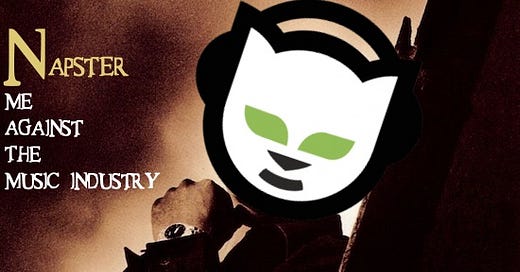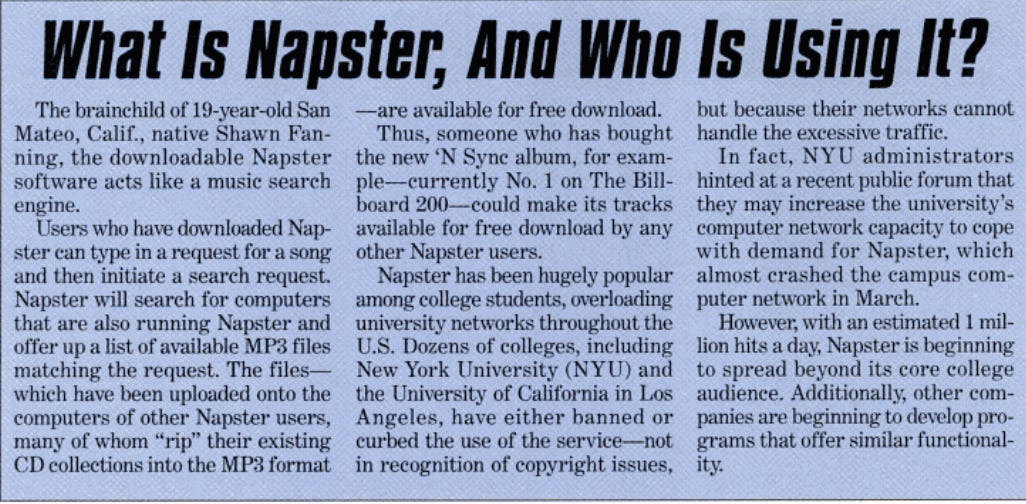As the late-great Marvin Gaye once said, I love music. I also love how easy it is to listen to. I just pick up my phone and I’ve got the entire Class of 3000 soundtrack at my fingertips as long as I pay Spotify a monthly fee. They’ve got to support the military-industrial complex somehow. Listening to music like this might seem like a relatively new concept developed a decade ago if you’re not old enough to remember the 2000s. However, the concept of music streaming had existed as far back as the late 90s with the advent of Napster, the enemy of the music industry.
Napster originated in 1999 as a peer-to-peer file-sharing service that specialized in digital audio. Since apps weren’t a thing back then, it was a program that had to be downloaded on your computer. It was free which is part of the reason it became so popular. Another reason for the service’s popularity was the fact that it could be used to share copyrighted music with other users.
You could download the latest Jay-Z album and someone could click on your profile to see that you were downloading the album and also download it. Of course, you also had to deal with all the falsely labeled audio files uploaded by trolls. It created this system where users could just go down a rabbit hole of new music to discover.
Enter the Sandman
The music industry didn’t like that at all. In December 1999, the RIAA (Recording Industry Association of America) filed a lawsuit against Napster. After the world survived Y2K, Metallica followed suit or should I say lawsuit. The band’s issues with the company started when the demo for the song “I Disappear” was found on the service. Digging deeper, they found out that pretty much their whole catalog of unreleased music was on the service.
The band filed a lawsuit against the company on March 13, 2000 suing them for copyright infringement and racketeering. Shortly after the lawsuit began, Metallica had an online consulting firm comb through Napster over a random weekend in the Spring of 2000 and monitor which users were downloading Metallica’s songs. They ended up with a list of over 300,000 users. The band’s goal was for these users to be banned from using the service. In response Napster attorney Laurence Pulgram said the following:
“Napster will review the over 300,000 names that Metallica turned in as soon as possible. If the claims are submitted properly, the company will take appropriate actions to disable the users Metallica has identified .”
— CMJ New Music Report May 22, 2000
These users were eventually banned by the company and had their passwords blocked. Interestingly, about 30,000 of the 300,000 banned users claimed that they never even downloaded any Metallica songs. These users were likely telling the truth. As I mentioned before, Napster was infamous for its false file names.
For instance, when Dr. Dre got thousands of accounts banned for downloading his songs on Napster, one innocent user was banned. He mentioned that he renamed the Sesame Street song "It's Not Easy Being Green" with the name of a Dr.Dre song and was banned for it. I doubt the company really cared as they just wanted to comply and get these lawsuits over as quickly as possible.
The band’s war against music pirates didn’t stop there. Napster had become so popular at colleges that internet service on campus’ nationwide had slowed to a crawl. Some schools banned the program from their respective networks. Metallica picked up on this and named schools such as the University of Southern California, Yale University, and Indiana University in their lawsuit filing for continuing to allow students to use Napster. Yale and Indiana University were eventually dropped from the case after banning the service.
Metallica was seeking $10 million dollars in damages. Dr. Dre filed his own lawsuit against the company as well, sharing the same attorney as Metallica. Howard King, the lawyer for both plaintiffs, continued trying to get colleges to ban students from using the service. He sent a letter to Harvard and Columbia along with other well-known U.S. institutions asking them to prevent students from using Napster. Not a single school he contacted complied with this request.
No Friends in the Industry (Or the California Judicial System)
While all of this happened, that RIAA lawsuit from 1999 was still ongoing. The organization was originally representing five major US record labels but this is the full list of plaintiffs in the suit:
A&M Records, a subsidiary of Universal Music Group
Geffen Records, a subsidiary of Universal Music Group
Interscope Records, a subsidiary of Universal Music Group
Sony Music Entertainment
MCA Records, a subsidiary of Universal Music Group
Atlantic Records, a subsidiary of Warner Music Group
Island Records, a subsidiary of Universal Music Group
Motown Records, a subsidiary of Universal Music Group
Capitol Records, a subsidiary of EMI
LaFace Records, a subsidiary of Sony Music Entertainment
BMG Music d/b/a The RCA Records Label, subsidiaries of Sony Music Entertainment
Universal Records, a subsidiary of Universal Music Group
Elektra Entertainment Group, a subsidiary of Warner Music Group
Arista Records, a subsidiary of Sony Music Entertainment
Sire Records Group, a subsidiary of Warner Music Group
Polygram Records, a subsidiary of Universal Music Group
Virgin Records America, a subsidiary of EMI
Warner Bros. Records, a subsidiary of Warner Music Group
The RIAA claimed that Napster had created a haven for piracy and was suing for damages and revenue lost due to the company hosting illegal song downloads. Their case continued all the way into 2001. That February, the 9th Circuit of the US Court of Appeals ordered the company to remove all songs belonging to the plaintiffs from their service or else they would be shut down. The same occurred in the Dr.Dre and Metallica lawsuit one month later.
By September, the lawsuits had been settled and Napster was ordered to shut down until they could guarantee all copyrighted material had been removed from the service. They had also agreed to pay artists based on how many users downloaded their music. At this point, the company was in need of cash and needed to shift its business model. The service attempted to adopt a subscription fee but was forced to liquidate its assets by a bankruptcy judge on September 3, 2002.
Final Thoughts
Obviously, Napster was in the wrong during this whole ordeal. However, it was a necessary evil in the music industry for consumers at least. If it hadn’t come along and rocked the boat when it did, we’d probably still be going to music stores and purchasing CDs because labels didn’t want to go digital. Legendary rapper Chuck D talked about how revolutionary Napster was in an issue of Billboard:
“Napster is turning the industry into something like the baseball card industry. Once more people understand how it works, it’s going to explode unlike anything you’ve ever seen before.”
– Chuck D, Billboard April 15, 2000
In the past 20 years, tons of digital music storefronts and streaming services popped up leading to the current music streaming landscape we now live in where it seems like Spotify and Apple Music are the only two services most people use. Napster managed to be resurrected in the 2000s and seems to be doing pretty well nowadays as a streaming servi—Wait what’s that? Napster’s now involved with NFTs and crypto despite the NFT and crypto markets losing a ton of value recently. Come again? Several crypto exchanges have stopped withdrawals of money?
I guess shady business practices are a part of Napster’s DNA. The service is now associated with the scummy world of NFTs and crypto but it should be remembered for its impact on the music industry and forcing record labels to change their old ways.





